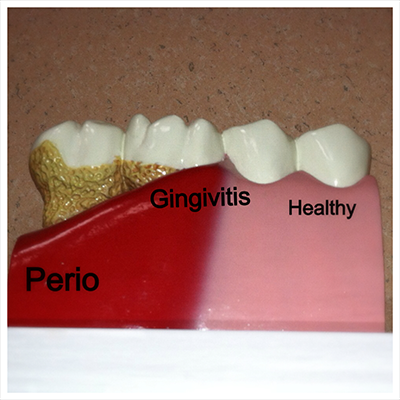Gum Therapy

Gum therapy is based on two main diseases/symptoms.
Gingivitis:
This is the inflammation of your gum tissue and can be the early stage of periodontal disease. Symptoms include redness, bleeding, tenderness and swollen gums. Everyone at some point of their lives has had gingivitis. It is caused by plaque (bacteria) irritating your tissue if it is not properly removed by proper tooth brushing, flossing daily and not keeping up with hygiene appointments. It does NOT affect your bone and ligaments that support your teeth. Good home care and routine visits are essential to keeping your gums healthy. Gingivitis is reversible if you treat your gums with good care!
Periodontal disease:
Gum disease is an infection of the tissues that surround and support your teeth. This disease is one of the major reasons of tooth loss in adults. Because gum disease is usually painless, you may not know you have it. It can start out as untreated gingivitis and the bacteria starts to affect the supporting structures of your teeth (ligaments and bone). Once it has reached this point it is NOT reversible, BUT with treatment and patient compliance it can be managed. Your bone and ligaments that support your teeth are important for maintaining your teeth! Think of it as a house…if your foundation is not solid, what happens to your house??
The hygienist use a tiny ruler, called a periodontal probe, to evaluate the health of your gums. The measurements are in millimeters and range from 1-15mm. Every tooth has a natural “pocket”, which is where your gum tissue meets your tooth. This is the area which you floss, but it wraps all around each tooth as a “collar”. Healthy number readings are 1-3mm. 4mm and above indicate that there is disease present in that area. We do a complete periodontal exam once a year. This helps us determine if your pocket readings (if they are above 3mm) are due to gingivitis or periodontal disease.
If you are a smoker, or have uncontrolled diabetes you are at high risk for periodontal disease. It can also be due to genetics or lack of good home care/coming in for routine visits.
The key is detecting the disease early before you experience any bone loss, or tooth loss! Just because you do not have any symptoms does not mean the disease is not present. Some symptoms include redness, bleeding, tenderness and swollen gums, and in some more severe cases some mobility or movement in your teeth.









